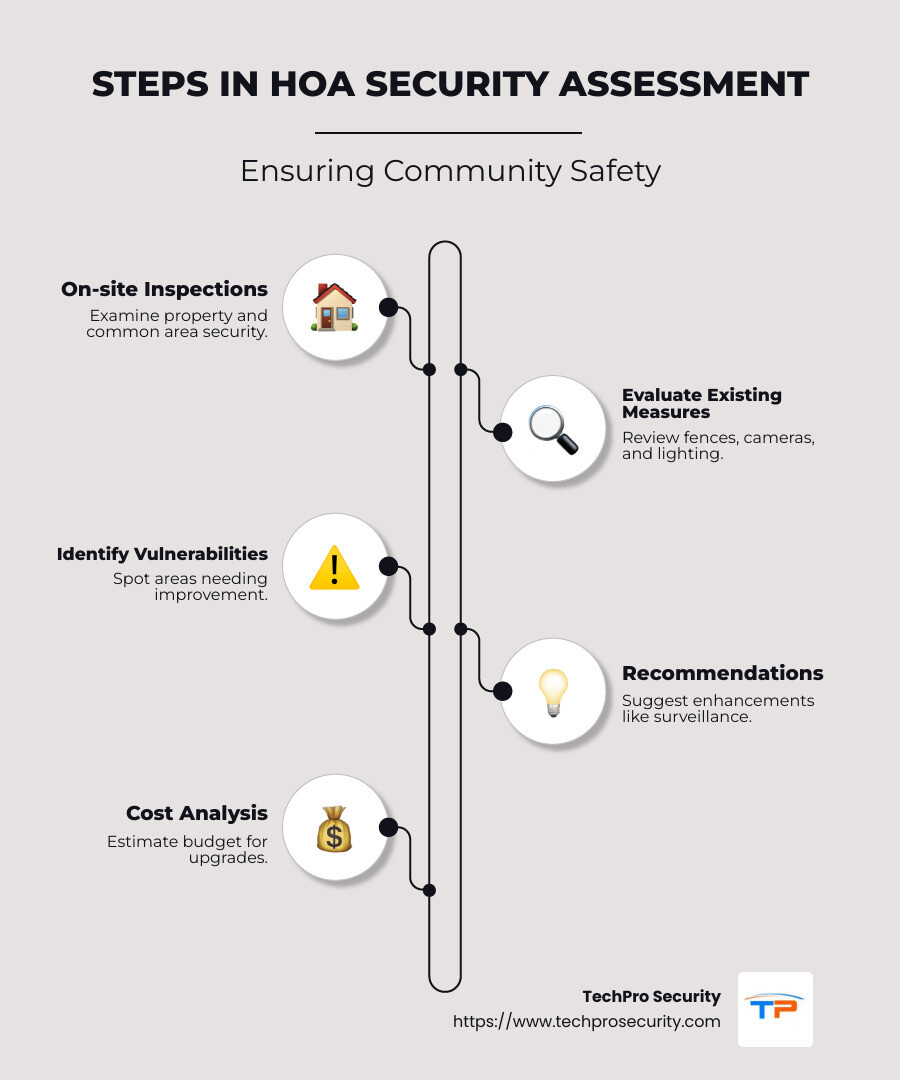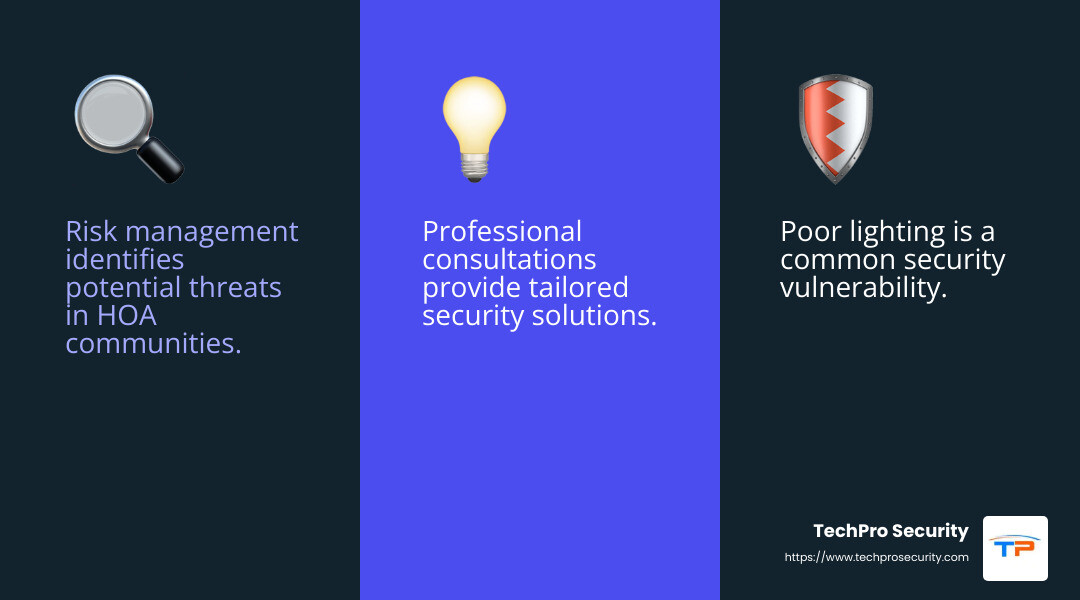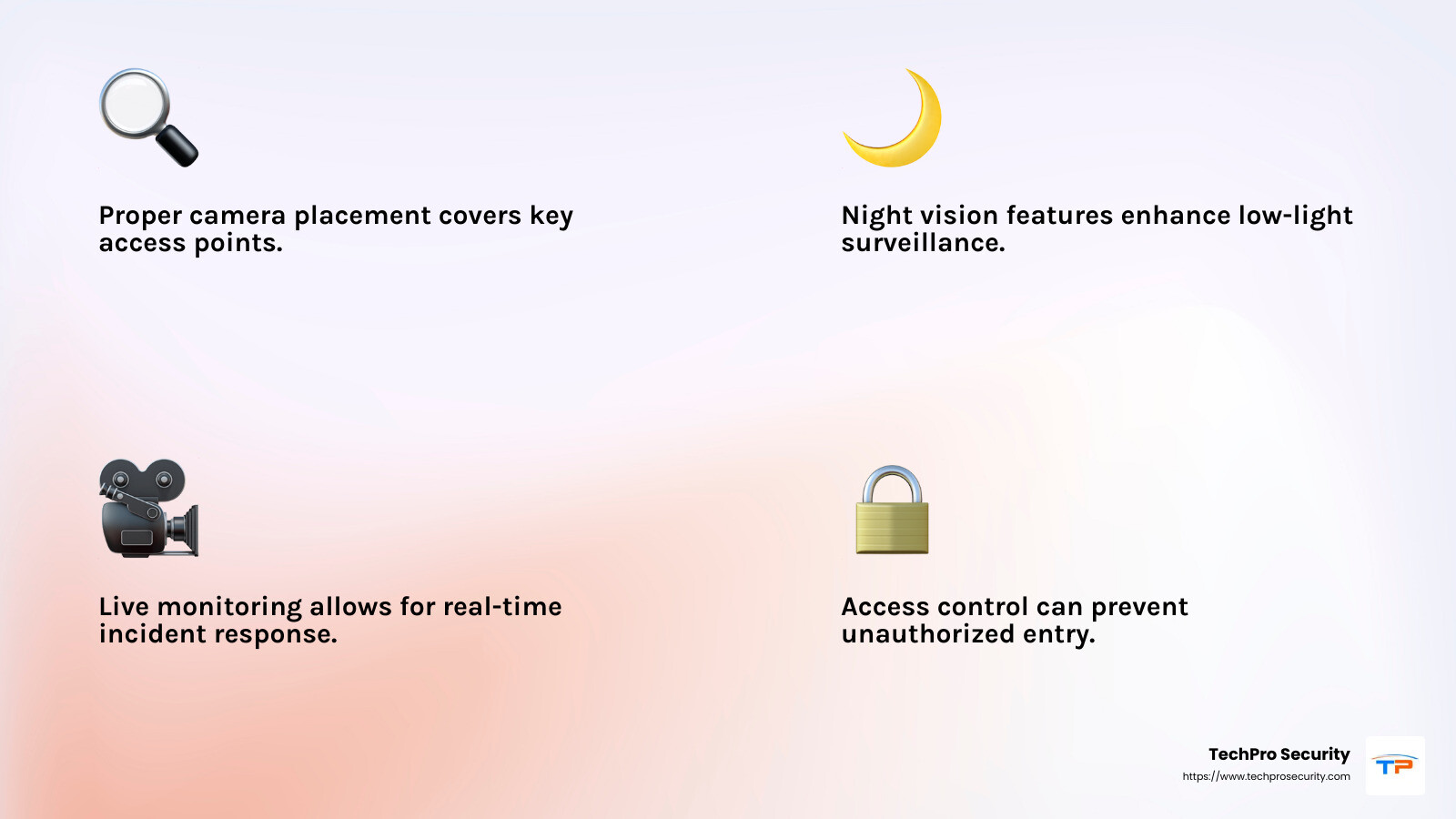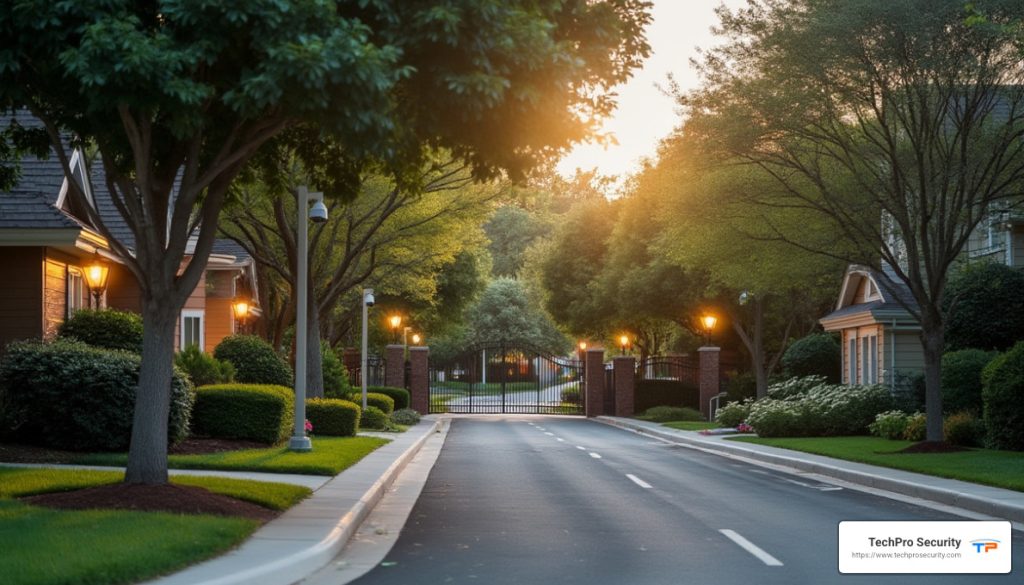HOA Security Assessment: Top 5 Powerful Solutions 2025
Ensuring a safe and secure community is a top priority for every homeowner association (HOA) and conducting an hoa security assessment is an essential step in achieving this goal. This assessment is a comprehensive review of the current security measures in place, identifying vulnerabilities, and planning improvements. It typically includes:
- Evaluating Physical Security: Inspecting gates, fences, and locks to ensure they are robust and in good condition.
- Technological Solutions: Reviewing the effectiveness of surveillance cameras and access control systems.
- Community Engagement: Assessing the involvement of residents in neighborhood watch activities and other safety programs.
By addressing these areas, HOAs can create a safer environment for all residents.
- On-site inspections of property and common areas
- Evaluation of existing security measures like fences, cameras, and lighting
- Recommendations for enhancing safety, such as improved surveillance and access controls
- Cost analysis for suggested security upgrades
- Engagement with local law enforcement for expert advice and crime prevention tips
By investing time and resources into a thorough security assessment, HOAs can proactively address risks and create a secure environment for residents.
I’m Brad Besner, an experienced security expert and founder of TechPro Security. With years of industry expertise, I’ve worked to improve hoa security assessment practices, specifically focusing on custom solutions for residential communities. Let’s dig into how a well-executed security assessment is the cornerstone of a safe and thriving neighborhood.

Understanding HOA Security Assessment
Risk Management is at the heart of any effective hoa security assessment. It’s all about identifying potential threats and vulnerabilities that could impact the safety of a community.
Security vulnerabilities can range from poor lighting in common areas to outdated access control systems. Each vulnerability is a potential entry point for crime, making it crucial for HOAs to address these issues promptly. For instance, inadequate lighting can create shadows that provide cover for intruders, while unsecured entry points can be an open invitation to burglars.
A professional consultation can be invaluable when conducting a security assessment. While some HOAs may choose to perform their own evaluations, hiring professionals can provide a more thorough analysis, especially in communities that have experienced repeated break-ins or vandalism. Professionals bring expertise and can offer custom solutions that are both effective and cost-efficient.

During a professional consultation, experts will conduct an on-site inspection, examining everything from the sturdiness of entry doors to the effectiveness of existing surveillance systems. They may also suggest improvements like installing more surveillance cameras or enhancing access controls. The goal is to provide the HOA with a clear action plan to improve security.
Case Study: In a community that had several instances of vandalism, a professional security assessment identified poorly lit areas as a significant vulnerability. By installing additional lighting and enhancing surveillance, the community saw a marked decrease in incidents.
A well-executed security assessment not only identifies risks but also empowers HOAs to take informed actions. By addressing vulnerabilities and implementing expert recommendations, communities can significantly improve their safety and peace of mind.
Conducting a Comprehensive HOA Security Assessment
A comprehensive HOA security assessment starts with a detailed on-site inspection. This involves walking through the property to identify any potential security gaps. During this inspection, it’s crucial to evaluate areas such as entry doors, windows, and common areas to ensure they are secure.
On-Site Inspection
The on-site inspection is the backbone of the assessment process. It should include:
- Entry Points: Check if doors are solid core and fitted with deadbolts. Ensure strike plates are secured with 3” screws to prevent forced entry.
- Windows: Verify that all windows, even those on the second floor, close properly and have functional locks.
- Lighting: Assess outdoor lighting, particularly in parking areas and entrances, to eliminate dark spots where intruders might hide.
- Landscaping: Ensure shrubs and trees are trimmed to prevent them from being used as hiding places.
- Access Control: Evaluate how well access to the property is managed. This includes checking if fire stairs are locked from the outside to prevent unauthorized entry.
Identifying Security Gaps
The inspection aims to uncover security gaps that could be exploited by potential intruders. Some common vulnerabilities include:
- Inadequate Lighting: Poor lighting can create opportunities for crime. Installing additional streetlights or motion sensor lights can help.
- Surveillance Blind Spots: Insufficient camera coverage can leave areas unmonitored. Assessing and repositioning cameras can close these gaps.
- Access Control Issues: Faulty or outdated systems can compromise security. Upgrading these systems ensures better control over who enters the community.
Cost of Assessment
The cost of a security assessment can vary. Typically, a written assessment for a condominium complex starts at around $1,500 and can go up to $5,000. This cost covers the identification of vulnerabilities and the documentation of solutions. Additional expenses may arise if the HOA decides to implement recommended improvements, such as installing new security equipment or hiring on-site personnel.
It’s important for HOAs to consider these costs as an investment in the community’s safety. A thorough assessment can prevent costly incidents and provide peace of mind for residents.
By conducting a comprehensive HOA security assessment, communities can proactively address security gaps and improve overall safety. This process not only identifies potential risks but also lays the groundwork for implementing effective security solutions.
Key Components of an Effective Security Plan
Creating a robust security plan for your HOA involves several key components. These include physical security, establishing clear security policies, and engaging the community through a neighborhood watch program.
Physical Security
Physical security is the first line of defense for any community. It involves securing the perimeter and access points of the property. Here are some essential elements:
- Fencing and Gates: As the saying goes, “Good fences make good neighbors.” Durable fencing materials that are difficult to climb or breach can significantly improve security.
- Lighting: Well-lit areas deter criminal activities. Ensure all pathways, entrances, and parking areas are adequately illuminated.
- Surveillance Cameras: Strategically placed cameras provide constant monitoring and can deter potential intruders. They also offer valuable evidence if an incident occurs.
Regular inspections and maintenance of these physical elements are crucial. Neglecting them can increase liability, while proactive measures can shield the community from potential risks.
Security Policies
Having clear and enforceable security policies is vital. These policies should cover:
- Access Control: Implement systems that manage who enters and exits the community. This could include key cards or codes that are regularly updated.
- Incident Reporting: Establish a straightforward process for reporting suspicious activities or security breaches.
- Resident Guidelines: Provide residents with guidelines on how to maintain their personal security and the security of shared spaces.
Consistent enforcement of these policies ensures that everyone in the community understands and adheres to the security measures in place.
Neighborhood Watch
A neighborhood watch program is one of the most effective ways to improve community security. According to the National Crime Prevention Council, these programs are crucial in deterring crime. Here’s how to get started:
- Organize Meetings: Coordinate with local law enforcement to train residents on recognizing and reporting suspicious activities.
- Engage Residents: Encourage neighbors to be vigilant and report any unusual activities. Active participation is key to the program’s success.
- Communication Channels: Use social media or community bulletin boards to share updates and alerts quickly.
By fostering a sense of community vigilance, a neighborhood watch program can be a powerful tool in preventing crime and promoting safety.
Implementing these components as part of a comprehensive security plan can significantly improve the safety and well-being of your community.
Implementing Security Solutions
Once you’ve laid the groundwork with a strong security plan, it’s time to put those plans into action. This involves deploying security cameras, establishing solid access control measures, and enhancing lighting throughout the community. Let’s explore how each of these solutions can boost your HOA’s security.
Security Cameras
Security cameras are your community’s watchful eyes. They don’t just record; they deter crime. Installing them at strategic points like entryways, parking lots, and common areas is crucial.
- Camera Placement: Make sure cameras cover key access points and potential blind spots. This ensures comprehensive monitoring.
- Advanced Features: Consider cameras with features like motion detection and night vision. These can provide superior surveillance, even in low-light conditions.
- Monitoring: Decide if you need live monitoring or if recorded footage will suffice. Live monitoring can offer real-time response to incidents.

Access Control
Access control systems are vital for managing who enters and exits your community. These systems can range from simple keypads to advanced biometric scanners.
- Key Cards and Fobs: These are easy to use and can be deactivated if lost, offering a balance of convenience and security.
- Visitor Management: Implement a system where visitors are logged and screened before entry. This adds a layer of oversight.
- Regular Updates: Ensure access codes or permissions are updated regularly to prevent unauthorized access.
Lighting
Good lighting is a simple yet powerful deterrent to crime. It ensures that all areas are visible, reducing hiding spots for potential intruders.
- Strategic Placement: Light up all pathways, entrances, and parking areas. Don’t forget places like playgrounds or community pools.
- Motion Sensors: These lights save energy by activating only when movement is detected, surprising any would-be intruders.
- Regular Maintenance: Check bulbs and fixtures regularly to ensure they’re working correctly. A single broken light can create a vulnerable spot.
Implementing these security solutions not only protects your community but also improves the residents’ sense of safety. When people feel secure, they are more likely to engage positively with their community, fostering a more vibrant and cohesive neighborhood.
Frequently Asked Questions about HOA Security Assessment
What is included in a security assessment?
A HOA security assessment is a thorough examination of your community’s security measures. It identifies potential risks and vulnerabilities. The assessment covers both physical security strategies and technological solutions.
-
Physical Security: This includes inspecting doors, windows, and locks. Are they sturdy and well-maintained? Are common areas well-lit and free of hiding spots?
-
Technological Solutions: This involves evaluating the use of security cameras, alarm systems, and access control systems. Are these technologies up to date? Do they effectively cover all high-risk areas?
By addressing these aspects, an HOA can pinpoint weaknesses and develop a robust security plan.
How often should an HOA conduct a security assessment?
Regular annual assessments are recommended to keep up with evolving security needs. Communities change over time, and so do security threats.
- Evolving Needs: As new residents move in and old ones leave, access control systems and security protocols may need updating. Additionally, any changes in the physical layout of the community, like new buildings or landscaping, can impact security.
Routine assessments ensure that your HOA is always prepared to tackle new challenges and maintain a safe environment for residents.
What are the costs associated with a security assessment?
The cost of a security assessment can vary. Typically, a complete written assessment ranges from $1,500 to $5,000. This cost covers the identification of risks and vulnerabilities and includes recommendations for improvement.
-
Assessment Costs: These include the initial evaluation by security professionals. It provides a detailed report on the current state of security and areas that need attention.
-
Additional Services: Beyond the assessment, there might be costs for implementing recommended solutions. This could involve installing new security cameras, upgrading locks, or hiring security personnel.
Investing in a security assessment and subsequent improvements is crucial. It not only improves safety but also protects the community’s reputation and property values.
Conclusion
In our journey to create safer communities, TechPro Security stands out as a trusted partner. With our custom security solutions, we focus on the unique needs of each HOA, ensuring comprehensive protection and peace of mind for all residents.
Our expertise in custom solutions allows us to address specific vulnerabilities identified during a HOA security assessment. Whether it’s installing advanced security cameras, upgrading access control systems, or enhancing lighting in common areas, we ensure that every measure is both effective and affordable.
Community safety is at the heart of what we do. We believe that a secure environment fosters a thriving community. By working closely with HOA boards and residents, we develop strategies that not only deter crime but also promote a sense of unity and vigilance among neighbors.
Investing in security is not just about preventing incidents today; it’s about safeguarding the future. With TechPro Security, you’re choosing a partner committed to excellence, reliability, and the safety of your community.
For more information on how we can improve your HOA’s security, visit our HOA Community Security page. Let’s work together to build a safer tomorrow.

